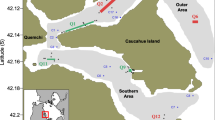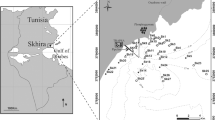Abstract
Benthic macrofauna and bottom sediments were sampled at 7 stations along a 24 km long onshore-offshore transect ranging in depth from 12 to 42 m in Cape Cod Bay, Massachusetts, USA. High faunal density, biomass and species diversity were recorded at stations densely populated by tubicolous polychaetes. These tube mats bind and stabilize the substratum, providing solid surfaces for attachment of epizoans. Three suspension-feeding species, Euchone incolor (polychaete), Thyasira gouldi (bivalve) and Aeginina longicornis (amphipod), co-occur with deposit-feeding species on muds resuspended by tidal currents. Hydrographic profiles of temperature, salinity and turbidity indicate that resuspended silt-clay particles are entrapped in dense water below the summer thermocline, which persists from mid-April to mid-October. The zone of intersection of the thermocline with the sea floor in about 22 m of water defines a major biofacies-lithofacies transition. This ecotone is characterized by high faunal density, biomass, and species diversity. Benthic populations of macrofauna from Cape Cod Bay are larger than those from Buzzards Bay, Massachusetts, and have a widely different taxonomic and trophic composition.
Similar content being viewed by others
Literature cited
Allen, J. A.: On the basic form and adaptations to habitat in the Lucinacea (Eulamellibranchia). Phil. Trans. R. Soc. (Ser. B) 241, 421–484 (1958).
Banse, K. and K. Hobson: Benthic polychaetes from Puget Sound, Washington, with remarks on four other species. Proc. U.S. natn. Mus. 125 (3667), 1–53 (1968).
Bock, W. D. and D. R. Moore: A commensal relationship between a foraminifer and a bivalve mollusk. Gulf Res. Rep. 2, 273–279 (1968).
Brillouin, L.: Science and information theory, 2nd Ed. 320 pp. New York: Academic Press 1962.
Buchanan, J. B.: The bottom fauna communities and their sediment relationships off the coast of Northumberland. Oikos 14, 154–175 (1963).
Enequist, P.: Studies on the soft-bottom amphipods of the Skagerrak. Zool. Bidr. Upps. 28, 297–492 (1949).
Estcourt, I. N.: A note on the fauna of a ripple-marked sandy sediment in western Cook Strait, New Zealand. N. Z. J. mar. fresh Wat. Res. 2, 654–658 (1968).
Fager, E. W.: Marine sediments: effects of a tube-building polychaete. Science, N.Y. 143, 356–359 (1964).
Hough, J. L.: Sediments of Cape Cod Bay, Massachusetts. J. sedim. Petrol. 12, 10–30 (1942).
Krumbein, W. C. and F. J. Pettljohn: Manual of sedimentary petrology, 549 pp. New York: Appleton-Century-Crofts, Inc. 1938.
Maurer, D.: Filtering experiments on marine pelecypods from Tomales Bay, California. Veliger 9, 305–309 (1967).
McKay, C. R. and D. J. Hartzband: Propylene phenoxytol: narcotic agent for unsorted benthic invertebrates. Trans. Am. microsc. Soc. 89, 53–54 (1970).
Niool, E. A. T.: The feeding mechanism, formation of the tube, and physiology of digestion in Sabella pavonina. Trans. R. Soc. Edinb. 56 (3), 537–598 (1930).
Odum, E. P. and H. T. Odum: Fundamentals of ecology, 546 pp. Philadelphia/London: W. B. Saunders Co. 1959.
Patten, B. C., D. K. Young and M. H. Roberts: Vertical distribution and sinking characteristics of seston in the lower York River, Virginia. Chesapeake Sci. 7, 20–29 (1966).
Phelps, D. K.: Functional relationships of benthos in a coastal lagoon. Ph. D. Thesis, 146 pp. Kingston, R. I., Univ. of Rhode Island. 1964.
Rhoads, D. C. and S. Cande: Sediment profile camera for in situ study of organism-sediment relations. Limnol. Oceanogr. 16, 110–114 (1971).
— and D. K. Young: The influence of deposit-feeding organisms on sediment stability and community trophic structure. J. mar. Res. 28, 150–178 (1970).
— — Animal-sediment relations in Cape Cod Bay, Massachusetts. II. Reworking by Molpadia oolitica (Holothuroidea). Mar. Biol. 11, 255–261 (1971).
Sanders, H. L.: Benthic studies in Buzzards Bay. I. Animalsediment relationships. Limnol. Oceanogr. 3, 245–258 (1958).
—: Benthic studies in Buzzards Bay. II. The structure of the soft bottom community. Limnol. Oceanogr. 5, 138–153 (1960).
—: Marine benthic diversity: a comparative study. Am. Nat. 102, 243–282 (1968).
—, R. R. Hessler and G. R. Hampson: An introduction to the study of the deep-sea benthic faunal assemblages along the Gay Head-Bermuda transect. Deep Sea Res. 12, 845–867 (1965).
Yentsch, A. E., M. R. Carriker, R. H. Pabker and V. A. Zullo: Marine and estuarine environments, organisms and geology of the Cape Cod Region. An indexed bibliography, 1665–1965. Systematics-Ecology Program, Marine Biological Laboratory, Woods Hole, Massachusetts. 178 pp. 1966.
Author information
Authors and Affiliations
Additional information
Communicated by J. Bunt, Miami
Contribution No. 235 of the Systematics-Ecology Program, Marine Biological Laboratory, Woods Hole, Massachusetts, USA.
Rights and permissions
About this article
Cite this article
Young, D.K., Rhoads, D.C. Animal-sediment relations in Cape Cod Bay, Massachusetts I. A transect study. Mar. Biol. 11, 242–254 (1971). https://doi.org/10.1007/BF00401272
Accepted:
Issue Date:
DOI: https://doi.org/10.1007/BF00401272




